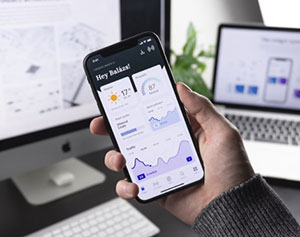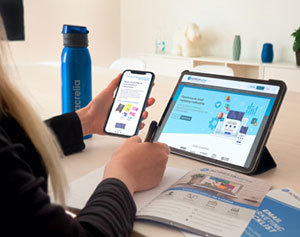Unlock B2B Marketing Success in Africa with These 5 Strategies

Blog post By Paula Chiocchi on 2025-08-13
As global interest in African markets rises, B2B brands are realizing what many on the continent have long known: success takes more than repurposing Western marketing playbooks. It requires authenticity, regional expertise, and an understanding of local digital behaviors.
On a recent episode of the B2B Influence podcast, we spoke with Datari Ladejo, founder and CEO of Fernhill Digital Consulting, a strategic marketing agency specializing in the West African market. With experience guiding both global and local brands to adapt their messaging for African buyers, Datari dove into her proven framework for creating impactful B2B campaigns across the diverse regions of this continent. Here are the key components of that framework:
1. Use Authentic Storytelling as Your Foundation
In African culture, stories and proverbs have been passed down through generations, and they continue to influence how people on the continent teach, learn and share information.
"Storytelling has always preserved our culture. Even now in a B2B context, we're able to adapt storytelling to this new reality that we have in the digital economy and tell our stories to people in a way that resonates with them.”
What's changed is that brands are no longer relying on Western cultural references to connect. Instead, they're embracing African narratives on their terms—through music, fashion, art, and digital platforms—creating more authentic and compelling messaging.
This shift in ownership of the narrative, powered by digital connectivity and cultural pride, has made storytelling a critical brand differentiator. Datari emphasized that companies that fail to reflect regional identity in their campaigns risk appearing tone-deaf or disconnected.
2. Hyper-localization Is Essential
Datari emphasizes that Africa is not one market. West Africa alone contains multiple countries with very different cultures, values, and languages. That's why her firm often partners with local specialists in each country to ensure campaigns reflect the appropriate cultural context. What resonates in Nigeria may fall flat in Ghana or Kenya. Even within countries, urban and rural experiences vary widely.
For a parallel to U.S. regional differences, consider this: a campaign directed at a New York audience would differ vastly from one targeted at the Deep South.
The takeaway for marketers is that hyper-localization is essential. Broad-brush approaches won’t work. Today's most successful B2B brands are tailoring language, visuals, and platforms to match the expectations of specific audiences—not entire continents.
3. Prioritize Mobile-First, Not Just Digital-First
Smartphone adoption in Africa is rising rapidly, and for many people, it’s their only digital access point. That’s why Datari says mobile-first design is non-negotiable for any B2B campaign.
Even in rural communities, someone may not own a laptop, but they’re more likely going to have access to a phone even if it’s shared within a community. She emphasizes that if marketers don't optimize their content for mobile, they’ll miss their audience.
At the same time, mobile usage comes with infrastructure constraints. Most Africans pay for data by the gigabyte, so content must be lightweight and fast-loading.
4. Use Content Formats That Fit the Infrastructure
Because mobile data is costly, brands must be strategic about content formats. Datari focuses on short, snackable videos that immediately grab attention and include a clear call to action.
Snackable content doesn’t mean simplistic content—it means focused—and It’s not about compressing a two-minute pitch into 15 seconds. It's about delivering a hook that invites the user to learn more.
Datari recommends:
- Short-form video (7–15 seconds) that leads to lightweight landing pages
- Text-based explainers for low-bandwidth users
- Localized visuals and languages to improve comprehension
5. Embrace Influencer-Led Trust Building
In a region where Datari says distrust can run deep, influencers have emerged as powerful bridges between brands and audiences. While influencer marketing started in B2C sectors like fashion, telecom, and food, B2B brands are now seeing success using influencers to drive awareness and engagement.
“These influencers built genuine communities before the hype arose,” she said. “When they endorse certain products, services, visions, companies, it adds that extra layer of trust … their audiences trust them, and that trust transfers to the brands they endorse.”
The bottom line is that, in Africa, trust, authenticity, and connection are key.
Final Takeaway
As more brands around the world seek to enter the African market, a top takeaway from the conversation with Datari is that marketers need to take time to understand the specific African region they are targeting. When they do this, their impact rises exponentially.
As an agency specializing in customer acquisition, we agree with this principle wholeheartedly. From our experience in the U.S. market, we know that when we dig deep to provide clients with robust knowledge of their target audience—whether through precision audience-building, B2B2C matching, intent data, or a combination of these or other approaches—we can realize dramatic improvements in campaign relevance, engagement, and business impact. You can read more about our services and our award-winning B2B2C database here.
For more information about Fernhill Digital, Datari can be reached at hello@fernhilldigital.com or visit fernhilldigital.com.
To catch the full podcast episode or learn about becoming a guest on B2B Influence, visit https://podcast.outwardmedia.com/.
DOWNLOAD YOUR FREE ebook
At OMI, we believe good things happen when you share your knowledge. That's why we're proud to educate marketers at every level - in every size and type of organization - about the basics of email marketing and the contact data that powers it.
-
The Executive's 15-Minute Guide to Building a Successful Email Marketing Database
-
A 15-Minute Guide to Fortune 2,000 Businesses and Executives
-
Five Best Practices for Using Email Marketing to Target SMBs



